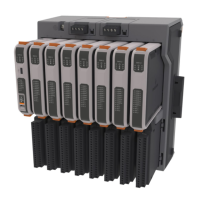Site Considerations for Equipment Installation, Grounding, and Wiring Manual
D301452X012
October 2019
Wiring Techniques 29
5.2.4 Use Known Good Earth Grounds
Controllers/flow computers should only have one connection to earth ground; this connection is
provided via the ground lug. Since these units are DC-based systems, grounding does not take into
account AC power grounding considerations. Earth-grounding the unit is mandatory when the unit
is equipped with a radio or modem. Additionally, connect units to earth grounds when they are
installed in areas that have frequent lightning strikes; are located near or used in conjunction with
equipment that is likely to be struck by lightning; or, if struck by lightning, may cause equipment or
associated system failure. Test and validate earth grounds as good before connecting to the
controller/flow computer, and then periodically test and maintain earth grounds (refer to Section
4).
5.2.5 Earth-ground Wires
Earth connections must use smoothly dressed large wire. Use AWG 3 or 4 stranded copper wire
with as short a length as possible. Exercise care when trimming the insulation from the wire ends.
Ensure either that all internal wires are secured by crimping a lug onto the wiring or are secured in
accordance with your organization’s standards.
Clamp or braze the earth ground wire to the
ground bed conductor (typically a standard AWG 0000 copper cable). Run the earth ground wire so
that any routing bend in the cable is a minimum 8-inch radius above ground or a minimum 12-inch
radius below ground.
5.2.6 Work Neatly and Professionally
Take pride in your work and observe all site and maintenance safety precautions. After properly
trimming the stranded pair wire ends, twist them in the same direction as their manufacturer did.
Ensure either that all internal wires are secured by crimping a lug onto the wiring or are secured in
accordance with your organization’s standards. Install the wire end into its connector and then
secure the associated connector’s clamping screw. Remember to check these connections for
tightness from time to time. If solid copper wire is use (in conjunction with the DC power system or
for earth ground), make sure that the conductor is not nicked when trimming off the insulation.
Nicked conductors are potential disasters waiting to happen. Neatly trim shields and coat them
whenever possible to protect them and to prevent shorts and water entry.
Remember that loose connections, bad connections, intermittent connections, corroded
connections, and other problems resulting from less-than-professional practices are hard to find,
waste time, create system problems, and confusion in addition to being costly.
5.2.7 Observe High Power Conductors and Signal Warning
When routing wires, keep high power conductors away from signal conductors. Space wires
appropriately to vent high voltage inductance. Refer to the National Electrical Code Handbook for
regulatory and technical requirements.
5.2.8 Use Proper Wire Size
Allow some slack in the wires when making terminal connections. Slack makes the connections
more manageable and minimizes mechanical strain on the printed circuit board (PCB) connectors.

